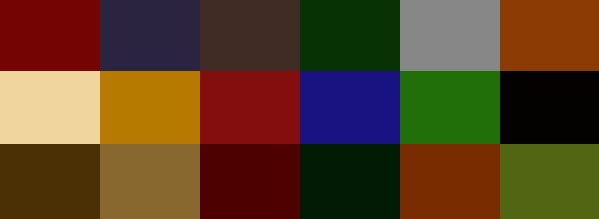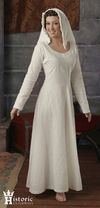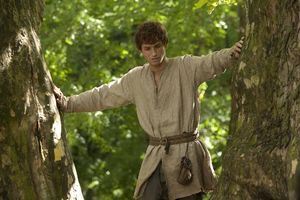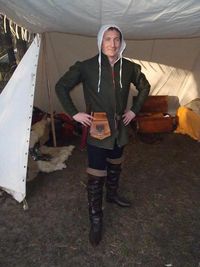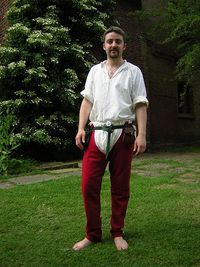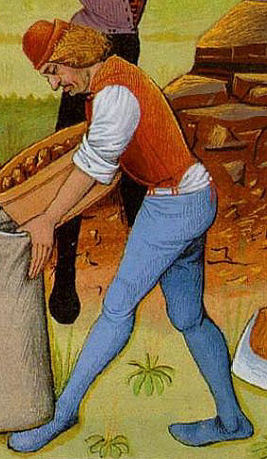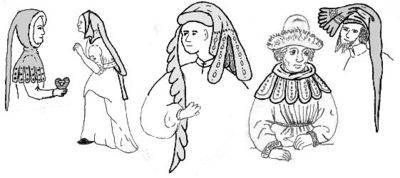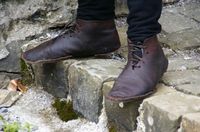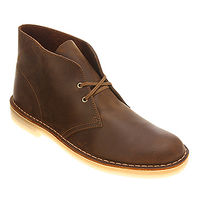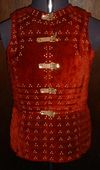The Marches costumes
Note: The tone and style of this page may need editing. All costume advice pages should be written in third person voice, using verbs that make clear that this page is advice, not direction.
Overview
This guide will help you achieve a great looking Marches costume, with the minimum effort and expense! There are three main sections which cover everything you'll need to know
- Inspiration, images, ideas and general information
- Creation; details of individual garments and how to find or make them
- Assembly; how to put it all together to create an outfit for any character
Inspiration
The Marches draws strongly on English history from the 12th century through to the Wars of the Roses for costume, weaponry and armour. This nation is intended to appeal strongly to re-enactors, partly because of the brief and style of the nation and partly because of the “low-fantasy” nature of the characters. The look is earthy, sober and simple.
Materials
Natural fibres are best for the Marches - wool, calico, linen and leather all work well to give an earthy, realistic look.
Colours
Plain flat colours, mostly the soft colours of natural dyes or unbleached cloth. The palette is autumnal and natural dull blues, greys, browns/rusts, mustards and greens, dull reds etc. especially at the lower end of the social scale. Wealthier Marchers will have deeper, brighter shades, but should stick to berry shades and jewel tones.
Historical inspiration
The Marches is the nation that draws most inspiration from real world costume, based around the medieval period of English history. Costumes should strongly evoke this period, although strict adherence to historical accuracy isn't required and a blending of styles from the medieval period, along with some fantasy elements, is expected. Much of the following information uses re-enactment or historical sources and terms simply to help you find further information on the sort of clothes to buy or make and aren't intended to intimidate the non-reenactor. That said, when researching the styles of the medieval period, re-enactment really is a great place to start. The information about re-enactment costumes is everywhere and there are lots of excellent photos and drawings to get you started. Google searches on Medieval re-enactment, Wars of the roses and 13th, 14th or 15th Century re-enactment will all provide helpful inspiration.
Both men and women can chose to adhere to medieval 'gender norms' as much or as little as they like and this guide only splits men and women's clothes from a historical point of view for simplicity's sake!
Women's costumes
The key women's garments for the Marches are kirtles and the cotehardie. Usually both of these dresses would be wool or possibly a heavy linen, and would be worn over a thinner linen shift. Headwear for women is either scarves or wraps, but hoods are common too. Tudor style kirtles with a fitted bodice and gathered skirt are not suitable for the Marches.
Men's costumes
Marcher men wear a number of variations of a tunic, cotehardie, or more fitted doublet. Later style doublets, with slashing and intricate decoration as worn in the Tudor period are not suitable for the Marches. Similarly, slashed 'landsknecht' styles are firmly within the nation of League and shouldn't be worn in the Marches.
Doublets and cotes should be worn either with narrow fitting trousers, or hose. Hats and caps are common, as are hoods, often with liripipe 'tails'.
TV and films
There are lots of TV shows that are useful for Marcher research: Pillars of the Earth, Cadfael, Brannagh’s Henry V, Blackadder the First, The Hollow Crown (which has an interesting interview with the costume designer to read on the BBC website)
Reenactment groups
Some links to reenactment groups' costuming guides - a helpful source of inspiration and information.
- Company of Saint Sebastian
- Buckingham’s Retinue
- Company of Saynt George
- The Medieval Siege Society
- St Hubert's Rangers
Pinterest pages
- http://pinterest.com/laurenowen/c15th-kit/
- http://pinterest.com/nikgaukroger/marches/
- http://pinterest.com/nikgaukroger/armour/
Bibliography
- The Medieval Tailor’s Assistant, Sarah Thursfield – Pretty much the bible for medieval costumes. Covers the layers from underwear to outerwear for the periods 1200-1500, plus headwear and accessories. Goes into detail about how to make the garments, which fabrics to use etc. A really excellent book.
- Medieval military costume, Gary Embleton – Very useful book using colour photographs of live models. Goes into detail about everything from 13th Century foot soldiers to 15th Century knights, with sections on underwear, armour, women’s dress and Landsknechts.
- Make Your Own Medieval Clothing for men, and for women, by W. Zerkowski and R. Fuhrmann, plus Headwear and Shoes available on the German website. Great books, giving designs for lots of different garments, though few instructions on how to make them. This would be more suitable for an experienced costume maker.
Similar nations
Dawn
The nation needs to contrast with its neighbour Dawn. That nation is Arthurian high romance; the plate is gleaming, the colours glorious, bright and vivid. In the Marches everything should have a grubby, worn, lived in look to it. The Marches is Kenneth Brannagh’s Henry V rather than Laurence Olivier’s. While there will be similarities between Dawn and Marches, Marcher clothes should be made from rougher fabrics, in softer colours. The Marches should look far more real and gritty than Dawn, with the colours dimmed and the decoration stripped back. Skirts and doublets should be less sumptuous, with narrower hems and thinner trims.
Higher class costumes will have a lot in common with average Dawn costumes, with richer colours and finer fabrics. Wealthy Marchers should still use a rich autumnal pallet of berry reds, jewel tone blues and greens and deep blacks, as opposed to the sunny and bright colours of the Dawn nobles. Riches should be shown discreetly in the Marches, through subtle touches of finer fabrics, in a lining perhaps, or through fancy buttons on an otherwise plain garment, unlike the more obvious Dawnish show with deep fur trims, expensive fabrics and wide, flowing robes and skirts.
There are also overlaps between the Marches' beaters, Wintermark's Steinr and the Navarr. Marcher beaters tend to wear light leather armour and simple, earth tone clothes, much like the Steinr and Navarr. The beaters can be pulled more into the Marches by using later medieval period clothing, like jacks rather than tunics, and accessorising with typical Marcher items, like bollock pouches and long belts. The look should be simple and unadorned but still structured, avoiding the large amounts of furs, pieces of leather and paints that the Navarr might wear.
Creation
Women's costumes
Women's dresses for The Marches are long, lean and smooth and laced to fit. Back lacing shows a high status, as help is required to do your dress up.
As with military clothes, dresses can reflect household livery. 'Parti-coloured' (or split coloured) dresses look very effective. Lara Corset's website gives an excellent overview of all aspects of women's wardrobes in the late 1400s,
Matilda la Zouche's wardrobe follows the reconstruction of several historically accurate outfits for a broad medieval period.
Some general pattern books are available which cover all types of women's wear:
- Medieval Women's dress
- High medieval women's dress
- The Medieval Tailor’s Assistant
- Make Your Own Medieval Clothing for women.
- Nehelenia Patterns - Multi part pattern for men and women
There are a range of historical dresses which suit the Marches. The kirtle is the basic pull on, t-shaped gown which was worn throughout northern Europe from the dark ages onwards. Later kirtles became more fitted and either button or lace up the front. These are often called cotehardies (there's also a shorter version of the cotehardie which men could wear). These dresses can also lace up the side, or in the back and can be as tight or loose as desired. They're usually worn over a lightweight underdress called a shift. All three of these dresses are straightforward to make either from patterns or from pattern diagrams and are easy to buy from both reenactment and LARP suppliers. Generally these dresses are made from wool, but heavier weights of linen or cotton are also suitable. The best looking dresses will be achieved by using fairly soft and heavy fabrics, as these create an attractively flowing skirt.
These dresses can be worn with the skirt tucked into the belt at the front to display the shift underneath, or show off a fancy lining. Aprons can be added on top for lower status women as well.
Women might want to consider wearing some of the men's costumes described below, particularly if they're taking to the battlefield. Most of these clothes could also be adapted to flatter a female figure - thigh or knee length cotehardies and doublets could work as well as a shorter dress, and livery coats can be made to look more 'feminine' by tailoring them to the waist and lengthening the skirts.
Some sources of information and patterns are given below.
Kirtles
- The underdress in this pattern Burda Patterns 7977
- Burda Patterns 7468
- Reconstructing History 018
- Authentic Patterns Late Medieval Kirtle
- Reconstructing History pattern RH002
- Basic pattern instructions
- Basic pattern instructions
- Nehelenia Kirtle pattern
- McCalls Pattern 4490
- McCalls Pattern 4491
- Butterick Pattern 4827
Cotehardies
Shifts
The shift, also called a smock or a chemise is a simple linen dress made the same way as a kirtle, but cut a little tighter and shorter to be worn as underwear. This style of under dress for women persisted unchanged well into the 18th Century.
This sort of dress needs to be made of something that will be comfortable next to the skin, and is breathable - cotton or linen are the best fabrics for this.
Many traders sell very simple dresses that will be suitable for a shift, but these simple dresses are also very easy to make yourself. Patterns for classic T-tunics can be used to make this dress by making a very long tunic with narrow sleeves, though extra panels will be needed in the skirt to allow for movement.
- T-tunic instructions
- How To - Make a T - Tunic
- Reconstructing History pattern RH018
- Reconstructing History pattern RH009
Men's costumes
Some general pattern books are available which cover all types of men's wear:
- High Medieval men's dress
- Medieval men's dress
- The Medieval Tailor’s Assistant
- Make Your Own Medieval Clothing for Men
- Nehelenia Patterns - Multi part pattern for men and women
The simplest item a Marcher man can wear is the T-tunic, which is a common garment throughout the Empire. Marcher men should stick to belted tunics with long sleeves, either no slits or a single slit in the front and no decoration. These tunics are a simple, loose fitting garment, and are most suitable for the lower classes. The tunic can also be more form fitting, and fasten with lacing or buttons up the front. This type of garment is usually called a cotehardie, and can be any length from high on the thigh, to floor length. Tunics can be either linen or wool, while cotehardie work best in wool, although heavier linen can work well too.
Tunics
Cotehardie
Doublet
A more complex and tailored option is the doublet, which became popular later in the medieval period and featured some distinctive variations, like the puffed shoulder, and the baggy upper arm. Doublets are usually between waist and thigh length and can fasten with buttons, lacing or hooks and eyes. Doublets are usually made of wool, but a heavier weight of linen will also work.
Shirts
A cotton or linen shirt should be worn underneath cotehardies and doublets. This will help to soak up sweat and stop the woollen garments from being too itchy. Marcher shirt are simple, with round necks, small 'key-hole' necklines or simple collars.
Shirts can be worn on their own as an alternative to a tunic, perhaps with a leather jerkin over the top.
- Reconstructing History 024 - multi item pattern
- Reconstructing History 008 - multi item pattern
- Tunic style shirt
Hose - joined and split
Marcher leg wear is slim fitting. Trousers are fine, but effort should be made to keep them narrow. Woolen hose are the more historical alternative, and come as split hose, which are two separate legs with or without integral feet, or joined hose which are one piece with a flap at the groin. Split hose should be worn with long braies, which are a mid thigh length, baggy boxer short style garment. Joined hose, and some split hose will tie or 'point' to either a doublet, or to a 'pourpoint' (literally meaning 'for pointing'), which is a waistcoat style top worn in much the same way as modern braces are! Split hose can also be held up by a belt, if they have loops at the tops of the legs.
Both braies and split hose are very easy to make from scratch, although joined hose are fairly complex to get the fit right, which is the vital component to stopping them splitting. The other important factor for making hose is to make them stretchy. This can be done by using boiled wool, which is naturally stretchy, or 'cutting on the bias' to use fabric's natural stretchy-ness. Hose are surprisingly easy to wear, as well as being comfortable and practical for day to day wear and for fighting.
Braies
Pourpoints
Trousers
Trousers can be made of wool or linen and any simple, slim fitting trousers will be fine for the Marches. Drawstring trousers are surprisingly simple to make, and most patterns for LARP or 'medieval' style trousers will be fine to use; don't forget that baggy or 'hero' style trousers aren't suitable!
Unisex items
Most Marchers will wear some sort of headwear. Hoods, coifs, caps and hats all add to the Marcher look.
Coifs
These can be made from linen, for every day wear, and from leather or padded linen or wool for combat. Coifs can be simple white linen, or embroidered and coloured for a fancier look.
- Coif pattern
- 3 different styles of coif pattern
- Shows how to alter the above pattern to create a nice cap for women
Hoods
Best made out of wool, or leather for beaters in particular. Another very variable garment with dozens of options for length, colour and decoration meaning a hood can be a simple or fancy as you like.
- Good information and patterns for hoods
- Cowl and hood
- Various hood patterns
- Reconstructing History 008 - Multiple head wear items
- Reconstructing History 009 - Multiple women's head wear items
Hats and caps
There are lots of hats suitable for the Marches, the key kinds are a simple skullcap, a square cap, an acorn cap and the bag or sack hat.
Cloaks
Marchers, being a practical people, have plenty of options for keeping the rain off. Cloaks can be simple half circles, or luxurious full circles. They come with and without hoods, can be decorated by dagging and fastened with pins, buttons or straps. There are a good list of cloak patterns given on this website.
Shoes
To stick with the classic medieval look for the Marches, a good style of shoe for men and women is the low ankle boot. These are readily available from re-enactment suppliers and with a little skill can also be made at home.
An excellent modern substitute is the desert boot. These can be bought in most shoe shops and online, and have the benefits of being cheap and having a waterproof sole.
Boots should be made of soft leather or suede and either buckle up the side, or tie or lace up. Boots for the rich can rise far higher than the ankle - even over the knee in some cases. Moccasin style boots without any tassels and other soft leather boots make a reasonable substitute for reeanctment boots.
Children's costumes
Children in the Marches can be dressed in scaled down versions of their parent's clothes. For toddlers and babies, traditional smocks, or simple t-tunics and drawstring trousers are simple and easy to pull-on garments, that can be made in linen or cotton for easy washing! These types of clothes also have plenty of flexibility in terms of size, meaning you'll get more than one year's use out of them. Small coifs, made as described above are great for keeping the sun off a baby's head and simple straw hats can also be used to stop children burning. Older children can either have their own costumes, or be given adult clothes which are then rolled up and belted to fit - the practical Marchers are unlikely to waste any clothing and hand me downs are a cheap (in and out of character!) way to clothe your children!
When making costumes for smaller children, remember to avoid anything tight around the neck - strings, cloaks, hats on cords etc and in addition, all tabards should secure under the arms. Make sleeves and armholes wider than needed; they're the bits that get tight as they grow. Neck holes also need to be bigger than for adults or should fasten at the back.
- Information on clothes and swaddling for babies
- Patterns for Medieval children's clothes
- Girls' dresses
- Boys' shirt, tunic and hood
- 'Mother and Daughter' dresses
Assembly
High status characters
Wealthier characters might wear finer robes, but wool not silk.
Back lacing shows higher status, and rich Marcher women can borrow from Dawnish styles, in particular the houppelande and burgundian gowns.
Dresses can be worn with the skirt tucked into the belt at the front to show off a fancy lining.
Middle status characters
Low status characters
Workers might wear sleeveless jerkins and leather trousers.
Aprons can be added on top of dresses for lower class women.
Monks
Both male and female monks wear traditional plain monks habit either in dark colours, or white with a dark scapula.
Marcher soldier
Stewards and wardens
The head of a household, a steward, wears richer colours, but wool not silk.
Beaters
Beaters are skilled trackers and gamekeepers. They watch the borders of the Marches. They are inspired by the classic British archers of the period mixed with the Rangers of Ithilien from Lord of the Rings. Beaters usually wear lighter armour, either just a padded or leather jack or else a leather tunic like the ones worn by the Rangers in Lord of the Rings.
Landskeepers
Some landskeepers wear robes, similar to the monk, but waistcoat-shirt-and-hose, with rolled-up sleeves is a good alternative.
Armour
Jacks
Poor Marchers may wear just a plain coloured padded jack or gambeson as their only armour. Wealthier yeomen have jacks in their household colours and mail or plate over the top if they have it. Richer people will add chain and maybe odd pieces of plate, like a gorget on top, while the rich will wear a full harness of plate. Beaters usually wear lighter armour, either just a padded or leather jack or else a leather tunic like the ones worn by the Rangers in Lord of the Rings.
Padded Jacks are fairly simple, though time consuming, to make from cheap calico quilted to 'batting' used to stuff quilts. The very simplest way is to make a T-Tunic as detailed in the men's clothes section, and simply sew the batting to the calico panels in straight lines before sewing the pieces together. More historically accurate gambesons can be made by sewing channels into the jack and stuffing them with fabric. Instructions for various styles are below;
- Batting stuffed gambeson
- Simple batting stuffed gambeson
- Handmade linen gambeson
- Stuffed jack
- Padded gambesons
- Various arming clothes - coifs, jacks and coat of plates
- Arming coat
- Historical arming coat
- Fancy arming coat
Brigandine
A good option for many Marchers with a bit of money is a brigandine, a series of overlapping metal plates inside a fabric shell. These can be home made, though require equipment to cut and rivet metal and take a lot of time and patience!
- Tutorial on how to make brigandine Patterns from 14th 15th and 16th centuries.
- Instructions and patterns
- 15th Century Archer
Livery
Any Marcher who owns farmland is a member of a Household, albeit perhaps a Household of one, and any Marcher Household can declare a livery. Members of the Household wear the livery colours in some way – perhaps as a coat, or perhaps as a simple sash or badge. Stewards of a Household that alies to a more powerful Household usually retain their own livery, or combine it with the new Households’ colours in some way. Households often wear matching livery jackets, although simple sashes or badges are also used to denote affiliation. Livery colours and badges can be repeated in civilian wear, and on banners, flags and camp decoration to identify and unite your group.
- Standards, Badges & Livery Colours of the Wars of the Roses, Pat McGill & Jonathan Jones, Freezywater Publications
- Heraldic Banners of the Wars of the Roses (3 vols), Pat McGill & Thomas Coveney, Frezywater Publications.
- Medieval Art and Woodcraft make livery badges, banners and flags, signage, medical charts etc. to order
Books
- The Medieval Soldier: 15th Century Campaign Life Recreated in Colour Photographs, Gerry Embleton & John Howe,
- English Medieval Knight 1400-1500, Christopher Gravett, Osprey Publishing
- The Great Warbow, Matthew Strickland & Robert Hardy, Sutton Publishing – probably the best accessible book you can get on the subject.
- Arms and Armour of the Medieval Knight, David Edge & John Miles Paddock, Saturn Books
Weapons
Bows are common, particularly for poorer characters. In hand-to-hand combat Marchers favour bills and other pole-arms.Two handed swords are common for richer characters in heavier armour, or warhammers, maces or poleaxes. Any historical weapons from the Hundred Years War and the Wars of the Roses are good: bollock daggers, axes, falchions, mauls, warhammers, poleaxes and bills.
Shields are uncommon in the Marche; the most common are small metal bucklers when they are used at all.
Shops
Costume sellers
- Arm Street Medieval and Fantasy clothing from Russia (English language website)
- Cloak’d and Dagger’d
- Historic EnterprisesAmerican based costume company. Trades at TORM
- Medieval Dress Company Clothing and leatherwork
- Matuls Clothing, armour tents and camp accessories from Poland (English language website)
- Midgard Seamstress UK LARP and Re-enactment costumes
- Revival Clothing
- Sally Green
- [http://www.sew-mill.com Sew-mill.
Armourers
- https://www.facebook.com/ArmourServices
- https://www.facebook.com/pages/The-Medieval-Rats/147041485362649
- http://www.armabohemia.cz/Novestr/homeA.htm
- http://www.armorymarek.com/
- http://www.bestarmour.com/
- http://www.capapie.co.uk/
- http://www.dtok.fsnet.co.uk/
- http://www.lancasters-armourie.co.uk/
- http://www.stgeorgearmouryshop.co.uk/index2.html
- http://www.whiteroseapparel.com/
- http://www.whiterosearmoury.com/
Leather items including shoes
- Phil Fraser
- Re-enactment shoes
- Historical Shoes
- Historic Shoes German company (English language website)
- Ravenswood Leather Items America site. Non-historical leather items.
Fur and traditional materials
- House of de Clifford Ethically sourced furs of all kinds
- Candles for All Ages Tallow and Beeswax Candles
- Herts Fabrics
- Bernie the Bolt
Camping accessories and other bits
- Sally Pointer Hats and bits and bobs
- Smoke and Fire American company.
- Medieval Market German company (English language website) – Clothing, furniture, and other items
- Medieval Dress Company Clothing and leatherwork
- Matuls Clothing, armour tents and camp accessories from Poland (English language website)
- Reenactors Shop German company (English language website) Lots of bits and bobs, including camping accessories.
- Medieval design 1st -16th century clothing, furniture and other historical products.
Flags, banners and livery badges
- Medieval Art and Woodcraft Historical and historically inspired banners, flags and livery badges
Pewter and cast goods
- Casts from the Past Pewter items including livery badges and some household items
- The Quiet Press Historical buckles, brooches and other ornamental metalwork
- Billy and Charlie's Finest Quality Pewter Goods American company. Pewter badges and other accessories.
- HR-Replikate German company. Jewellery based on archeological finds (English language website)
- Lionheart Replicas Pewterwear
- Pewter Replicas Pewter badges, household items and livery collars
Wooden items
- Douggie the Wood Wooden Furniture
- Robin Wood Authentic wood turned historical items
- Paul Atkin Bowls and other hand turned items
